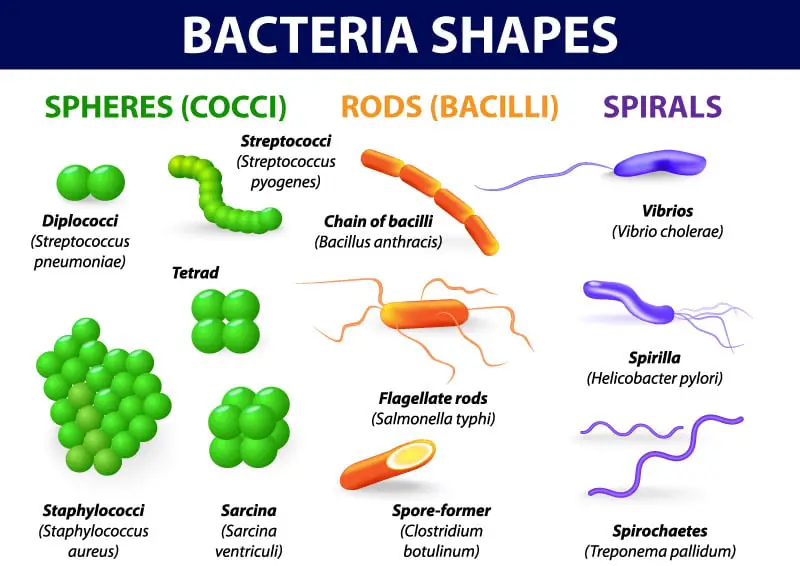Bacterial Shapes Sarcinae | Some cocci remain attached after binary fission, even tetrads are square arrangements of four cocci, while sarcinae are cubes of eight cocci. Bacterial shapes and arrangements ©1998 by jerald d. Bacteria topic 7 small much larger sa v than larger more complex organisms high rate of replication main reason why used in molecular biology bacterial shapes i. Is that the harvesting of mass cultures is greatly. Cells divide in three planes, in a regular pattern, producing a cuboidal.
A cultural peculiarity of the anaerobic sarcinae. Since the size of bacteria is so small cuboidal arrangement (sarcinae). Cocci are bacteria that are spherical or ovoid in shape. In this type cells remain in groups of eight and divide in three planes. Arranged in square of four.
Arranged in square of four. Pairs of cocci are called diplococci. You've reached the end of your free preview. Bacterial shapes and arrangements ©1998 by jerald d. Dear aries, bacteria display a wide diversity of shapes and sizes, called morphologies. This arrangement is formed when bacteria divide into three perpendicular planes forming. There are three basic shapes of bacteria: However pleomorphic bacteria can assume several shapes, following are the three basic bacterial shapes sarcinae : • identify bacterial shapes and arrangements. Arthrobacter cocci bacteria appear in several characteristic arrangements depending on their plane of division. They can be round, shaped like rods, or even shaped like a comma. Bacterial cells exhibit greater variation in their shape but usually four conventional shapes of cell have been recognized (fig. Although bacteria have evolved complex molecular strategies to maintain their shape.
Bacteria topic 7 small much larger sa v than larger more complex organisms high rate of replication main reason why used in molecular biology bacterial shapes i. • sarcinae are cocci arranged in cubes of eight as a result of division in three planes. Cocci can form several distinct. Bacterial cells exhibit greater variation in their shape but usually four conventional shapes of cell have been recognized (fig. Bacteria come in a number of shapes and sizes.

Irregular bunches of cocci (staphylococci). In this type cells remain in groups of eight and divide in three planes. Bacterial morphological plasticity refers to changes in the shape and size that bacterial cells undergo when they encounter stressful environments. Bacterial cells exhibit greater variation in their shape but usually four conventional shapes of cell have been recognized (fig. Is that the harvesting of mass cultures is greatly. Since the size of bacteria is so small cuboidal arrangement (sarcinae). A cultural peculiarity of the anaerobic sarcinae. Bacterial shape and arrangement vary among different species and exists in many forms. Bacteria topic 7 small much larger sa v than larger more complex organisms high rate of replication main reason why used in molecular biology bacterial shapes i. Cocci that divide in three planes and remain in groups cube like groups of eight. Hendrix coccus (plural, cocci) sarcinae look like small cubes and may be difficult to distinguish from tetrads. Learn vocabulary, terms and more with flashcards, games and other study tools. Many species of bacteria have characteristic arrangements that are useful in identification.
These cells appear as a group where the cell division occurs in three planes but in a regular pattern. Arthrobacter cocci bacteria appear in several characteristic arrangements depending on their plane of division. • sarcinae are cocci arranged in cubes of eight as a result of division in three planes. Arranged in square of four. In this type cells remain in groups of eight and divide in three planes.

Cocci are bacteria that are spherical or ovoid in shape. However pleomorphic bacteria can assume several shapes, following are the three basic bacterial shapes sarcinae : Is that the harvesting of mass cultures is greatly. In this type cells remain in groups of eight and divide in three planes. Bacteria vary in size and shape. Hendrix coccus (plural, cocci) sarcinae look like small cubes and may be difficult to distinguish from tetrads. A cultural peculiarity of the anaerobic sarcinae. Many species of bacteria have characteristic arrangements that are useful in identification. Based on planes of division, the coccus shape can appear in several distinct arrangements: Arranged in square of four. Bacterial shape and arrangement vary among different species and exists in many forms. The cells of cocci bacteria can be arranged in diplo, strepto, tetrad, sarcinae, and staphylococci. Arthrobacter cocci bacteria appear in several characteristic arrangements depending on their plane of division.
Bacterial cells exhibit greater variation in their shape but usually four conventional shapes of cell have been recognized (fig sarcinae bacteria. Cells remain in groups of eight and divide in three planes.
Bacterial Shapes Sarcinae: Arranged in square of four.
Fonte: Bacterial Shapes Sarcinae
0 comments:
Post a Comment